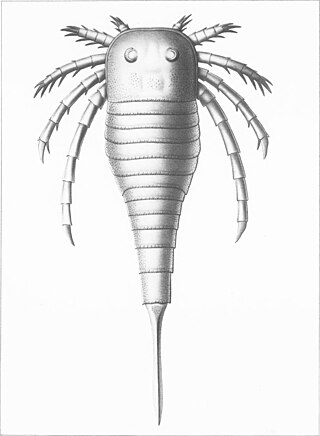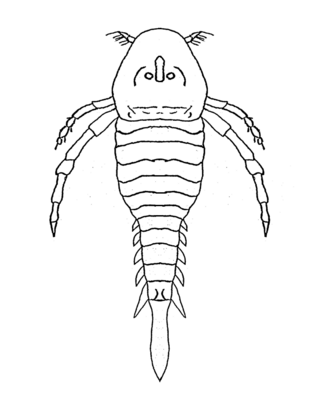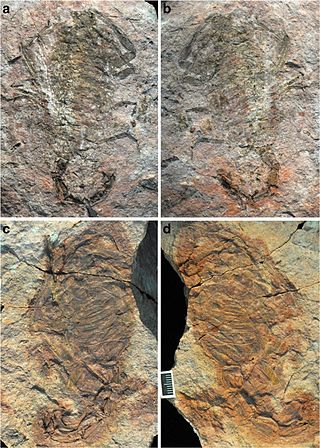Related Research Articles

Stylonurina is one of two suborders of eurypterids, a group of extinct arthropods commonly known as "sea scorpions". Members of the suborder are collectively and informally known as "stylonurine eurypterids" or "stylonurines". They are known from deposits primarily in Europe and North America, but also in Siberia.

Carcinosoma is a genus of eurypterid, an extinct group of aquatic arthropods. Fossils of Carcinosoma are restricted to deposits of late Silurian age. Classified as part of the family Carcinosomatidae, which the genus lends its name to, Carcinosoma contains seven species from North America and Great Britain.

Dorfopterus is a genus of eurypterid, a group of extinct aquatic arthropods. Only one fossil of the single and type species, D. angusticollis, has been discovered in deposits of the Early Devonian period in the Beartooth Butte Formation in Wyoming, in the United States. The first half of the name of the genus honors the discoverer of this formation, Erling Dorf, while the second half consists in the Ancient Greek word πτερόν (pteron), meaning "wing". The species name angusticollis is composed by the Latin words angustus ("narrow") and collum ("neck").
Salteropterus is a genus of eurypterid, an extinct group of aquatic arthropods. Fossils of Salteropterus have been discovered in deposits of Late Silurian age in Britain. Classified as part of the family Slimonidae, the genus contains one known valid species, S. abbreviatus, which is known from fossils discovered in Herefordshire, England, and a dubious species, S. longilabium, with fossils discovered in Leintwardine, also in Herefordshire. The generic name honours John William Salter, who originally described S. abbreviatus as a species of Eurypterus in 1859.

Parahughmilleria is a genus of eurypterid, an extinct group of aquatic arthropods. Fossils of Parahughmilleria have been discovered in deposits of the Devonian and Silurian age in the United States, Canada, Russia, Germany, Luxembourg and Great Britain, and have been referred to several different species. The first fossils of Parahughmilleria, discovered in the Shawangunk Mountains in 1907, were initially assigned to Eurypterus. It would not be until 54 years later when Parahughmilleria would be described.

Carcinosomatidae is a family of eurypterids, an extinct group of aquatic arthropods. They were members of the superfamily Carcinosomatoidea, also named after Carcinosoma. Fossils of carcinosomatids have been found in North America, Europe and Asia, the family possibly having achieved a worldwide distribution, and range in age from the Late Ordovician to the Early Devonian. They were among the most marine eurypterids, known almost entirely from marine environments.

Stylonuridae is a family of eurypterids, an extinct group of chelicerate arthropods commonly known as "sea scorpions". The family is one of two families contained in the superfamily Stylonuroidea, which in turn is one of four superfamilies classified as part of the suborder Stylonurina.

Stylonuroidea is an extinct superfamily of eurypterids, an extinct group of chelicerate arthropods commonly known as "sea scorpions". It is one of four superfamilies classified as part of the suborder Stylonurina.
Gigantoscorpio willsi is an extinct species of scorpion which lived between 345.0 million and 342.8 million years ago, during the Visean age of the Carboniferous. Its type specimen is BMNH In. 42706a,b, In. 42707, which is a 3D body fossil of its exoskeleton found near modern-day United Kingdom. It is thought to grew up to around 40 cm (16 in) long, but later study estimated its total length about 24 cm (9.4 in).
Palaeopisthacanthidae is an extinct family of scorpions.

The Parastylonuridae are a family of eurypterids, an extinct group of chelicerate arthropods commonly known as "sea scorpions". The family is one of two families contained in the superfamily Stylonuroidea, which in turn is one of four superfamilies classified as part of the suborder Stylonurina.

Kokomopteroidea is an extinct superfamily of eurypterids, an extinct group of chelicerate arthropods commonly known as "sea scorpions". It is one of four superfamilies classified as part of the suborder Stylonurina. Kokomopteroids have been recovered from deposits of Early Silurian to Late Devonian age in the United States and the United Kingdom.

The Kokomopteridae are a family of eurypterids, an extinct group of chelicerate arthropods commonly known as "sea scorpions". The family is one of two families contained in the superfamily Kokomopteroidea, which in turn is one of four superfamilies classified as part of the suborder Stylonurina.

The Hardieopteridae are a family of eurypterids, an extinct group of chelicerate arthropods commonly known as "sea scorpions". The family is one of two families contained in the superfamily Kokomopteroidea, which in turn is one of four superfamilies classified as part of the suborder Stylonurina. Hardieopterids have been recovered from deposits of Early Silurian to Late Devonian age in the United States and the United Kingdom.

Eurypterina is one of two suborders of eurypterids, an extinct group of chelicerate arthropods commonly known as "sea scorpions". Eurypterine eurypterids are sometimes informally known as "swimming eurypterids". They are known from fossil deposits worldwide, though primarily in North America and Europe.

Opsieobuthus is an extinct genus of centromachid scorpion. The type species O. pottsvillensis was named from the late Carboniferous of Clay City, Indiana. A second species ?O. tungeri was tentatively assigned to the genus from the Early Permian Chemnitz petrified forest in Germany.

Mycteropoidea is an extinct superfamily of eurypterids, an extinct group of chelicerate arthropods commonly known as "sea scorpions". It is one of four superfamilies classified as part of the suborder Stylonurina. Mycteropoids have been recovered from Europe, Russia, South America and South Africa. Mycteropoid specimens are often fragmentary, making it difficult to establish relationships between the included taxa. Only two mycteropoid taxa are known from reasonable complete remains, Hibbertopterus scouleri and H. wittebergensis.
Gigantoscorpionidae is an extinct family of scorpions that lived between 383.7 million and 342.8 million years ago, during the Devonian and Carboniferous periods. The family is the only member of the superfamily Gigantoscorpionoidea.

This timeline of eurypterid research is a chronologically ordered list of important fossil discoveries, controversies of interpretation, and taxonomic revisions of eurypterids, a group of extinct aquatic arthropods closely related to modern arachnids and horseshoe crabs that lived during the Paleozoic Era.
References
- ↑ "Scorpion classification". Walter Reed Biosystematics Unit, Smithsonian Institution. Archived from the original on April 25, 2010. Retrieved April 8, 2010.
- ↑ W. David Sissum (1990). "Systematics, Biogeography, and Paleontology". In Gary A. Polis (ed.). The Biology of Scorpions . Stanford University Press. pp. 31–160. ISBN 978-0-8047-1249-1.